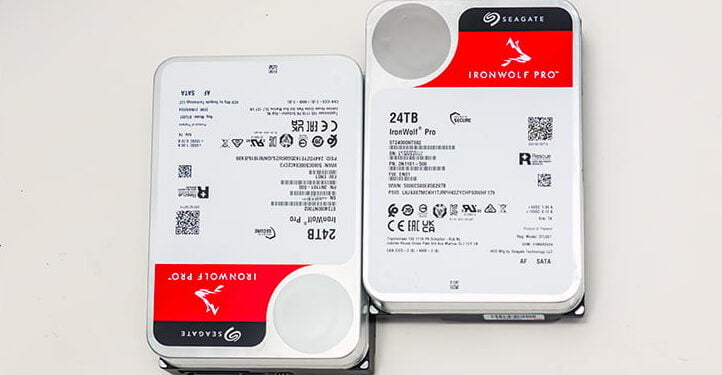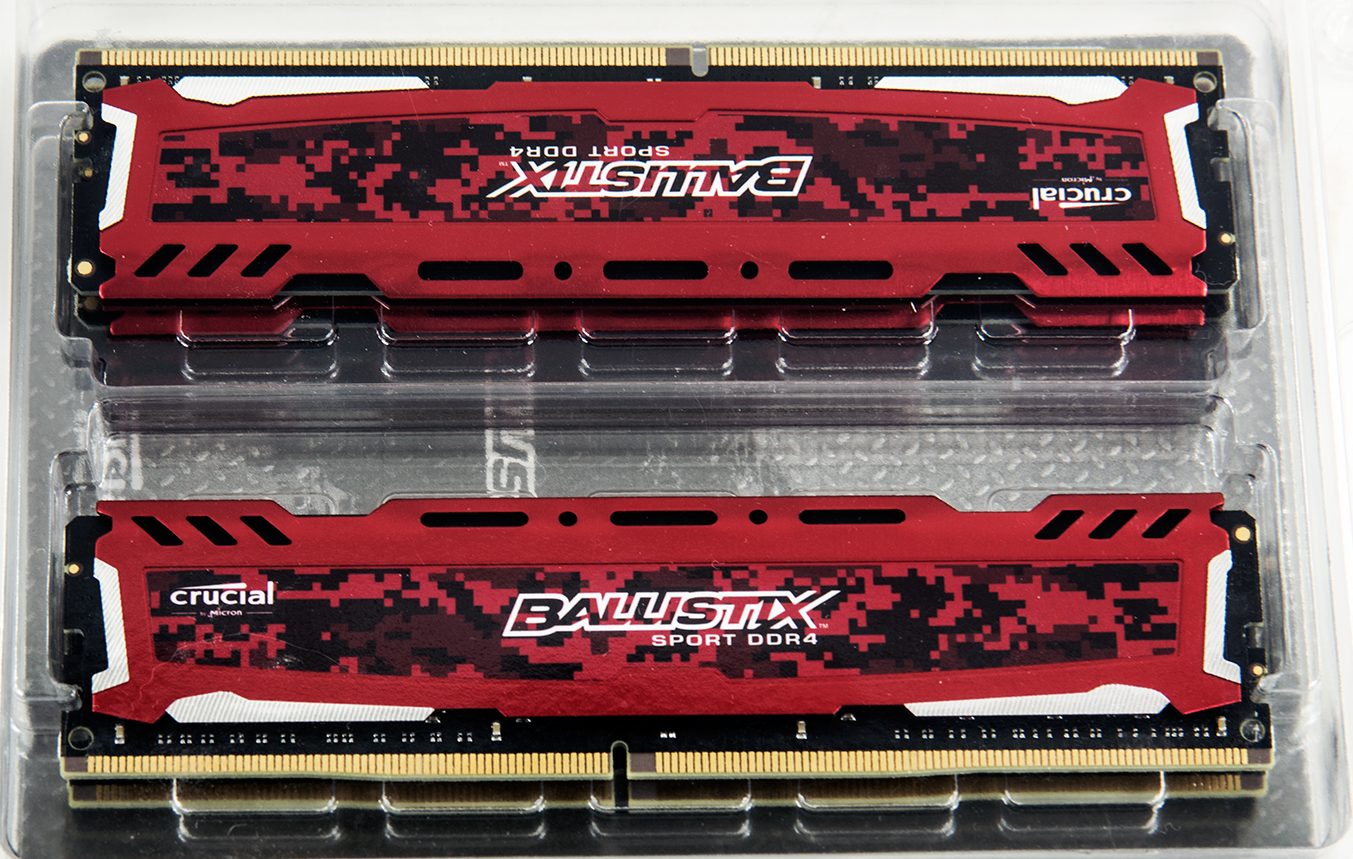
As expected, the IronWolf Pro 24TB does not differ all that much from its predecessor the IronWolf Pro 22TB. This should be expected as for the past couple generations, the IronWolf Pro series has not radically diverged from the Exos X on the hardware front. Put another way, the Exos X blazes the trail and the IronWolf Pro follows. So if the Exos X gets shiny new tech… the companion IronWolf Pro version also gets it. For those who do not follow storage technology trends this means that beyond labeling aesthetics the PCB is the same as the Exos X24. Said PCB is populated with the same 512MB RAM IC, the same dual core ARM SoC plus a low level Smooth controller, and very similar vibration sensors (albeit scaled down a tad). All Seagate does differently for the X24 is add more vibration sensors, load a different firmware for the controller… and extend the testing into OCD territory that covers all the IronWolf Pros and then continues on with scenarios than what the IronWolf Pro should ever encounter.

Why does Seagate offer two different series, meant for radically different environments and scenarios, at very similar price points when both are so gosh darn similar? Well that is a funny story that comes about because of consultants and the PHBs desire for ever increasing ‘belt tightening’. You see, not that long ago there were major hardware differences between these two models. So much so that the warranty itself was no where as good on the IronWolf Pro as it was on the Exos X series. Unfortunately, Seagate had so much bloat in their existing lineup, and had gotten QA and QC so under control, that they called in a consulting team to help them get their lines figured out. They did so as certain models were underselling and the days of having ‘left overs’ from the higher series to use on lower series were long past (from frame of reference of how it used to be done think how AMD and Intel CPU models still use ‘trickle down’ testing with i3 and r3 being a Seagate ‘Cuda, i5/r5 being the ‘Cuda Pro, R7/i7 non K being the IronWolf non-Pro, the i7K being IronWolf Pro, and at the top the R9/i9 being Exos X).

The end result was that the standard BarraCuda, the beloved ‘Cuda Pro, and the non-Pro IronWolf were given a gold plated watch, and the dreaded End Of Life title. Fast forward a couple years and Seagate has gotten their Quality Control so razor tight that the days of having enough ‘failed’ Exos X units to actually rebadge as IronWolf Pros are loooong gone. At which point a Dilbertesque PHB was rumored to want to also kill off the IronWolf Pro and certain consultants backed that asinine position with ‘data’. So why do we still have IronWolf Pro models released? Because Seagate’s RnD is just that good, and so refined, that “just” firmware modifications do matter… though mainly it is because HAMR was still not ready for primetime. Thus, the IronWolf Pro was removed from the hangman’s noose (rumors place right at 11:59.999999 and mere nanoseconds from officially being killed). Instead of being EOL’ed the IronWolf Pro’s firmware was further modified so as to be a bit more… flexible. Flexible enough so as to be able to carry the load that once was spread out over four different models: home/ home enthusiast storage (BarraCuda and BarraCuda Pro), home and small business NAS (IronWolf), and SMB NAS (IronWolf Pro).
That is a lot of weight to carry yet the IronWolf Pro’s have done it with aplomb. So much so that every year rumors of it and the Exos X series being in a Thunderdome death match continue to crop up. Sure. At some point CMR will no longer be inside an Exos line and it probably will be IronWolf Pro only. Those days are way, way in the future as HAMR has been given an entirely new sub-branding within Exos (Exos Mozaic 3+ that will then be called Mozaic 4 when the next, or next-next gen HAMR is released). In the mean time this does mean that for all but Enterprise consumers there is a lot of confusion on what this seemingly small change actually means in the real-world.

The upside to all this internal blood letting and ruthless optimization is Seagate has been able to keep inflation under control and routinely offer more storage capacity for the same MSRP points every year. Though mainly it means that IronWolf Pro has become even hardier and capable of handling even harsher environments… as the hardware is Exos X / ‘Enterprise’ grade. Thus the higher 550TB workload rating (instead of the older 300TB); the higher 2.5million MTBF rating (instead of 1.2M); and arguably the same premium internal component configuration including the premium grade TDMR read/write heads, and premium grade detector signal processor, that allowed Exos X to be better than the… less premium TDMR configuration in the older IronWolf Pro models.

So what is different? In a nutshell the IronWolf Pro uses a more ‘old school’ approach to carrying out write operations whereas the Exos X uses a newer ‘Super Parity’ variation to write operations. With Super Parity a write operation can take one of (at least) two (known) forms. A single write operation where the ECC Parity information is all written on one platter. As an example, but not necessarily how it does it, say in a ten platter Exos X24 the top 9 platters would be for the data and the bottom one would be for the entirety of the ECC parity data. All of which is carried out in one write operation. The other known method is a single write operation now takes two operations. Taking that selfsame Exos X24 and instead of a 9+1 configuration the first write operation writes using all 10 platters but it skips a track each time if fills a track up with data and only data. Then in a second operation (after the first is completed) it then goes back and fills the empty skipped tracks with the ECC parity data for the other tracks data.

The upside to Super Parity is the Super Parity blocks are given their own ECC parity bits thus giving the hard drive not one but two chances to recover data… before having to go to the RAID controller to try and recover it (aka a third try at recovery). This is important, darn near competition killer important, because with modern hard drives they are basically being held to the same one read failure for every 10E15 bits read standard. On paper that is a lot reads, but in the Enterprise area 10E15 is just a fancy way of saying 0.125 Petabyte read, or 125TB reads. Which still sounds like a lot, but drivers are getting bigger. With the 24TB’ers that works out to one unrecoverable read error for every 5.208 Full Drive Reads. Compare and contrast that with the X22s 5.682 FDR, the X20s 6.25 FDR… the X16’s 7.8125 FDR and this downward trend must be stabilized before Enterprise consumers revolt. Thus Super-Parity was born… and we believe that Seagate is simply not testing beyond the 10E15 standard to see how much more Super-Parity gives users.
The other upside to Super Parity layout is read performance can be slightly enhanced (if using the dual write / skip a track method) over old-school methods as it does not need to pass over the ‘useless’ parity information and thus the data read density is higher. The downside, and the reason the IronWolf Pro series does not come with it, is that write performance is going to be slower than the old method of laying down Data, then Parity, then Data, then Parity in a linear fashion. In testing the Exos X24 is indeed slightly slower at writes compared to the IronWolf Pro 24TB… but the opposite is true when dealing with sequential reads.

Please take note of the word slightly. Unless you routinely push Terabytes of data across your network (or even just your PC’s storage bus), the differences are not what we would call noticeable in the real world. This duality however does exist, and is big enough under certain circumstances, to be more than just a rounding error in synthetictesting. Basically what once could be put down to just ‘noise’ and randomness of testing, with 2.4TB platters (and ten of them per drive!) the differences between the two series are now ‘big’ enough to not just random noise in the results. As time goes by, and technology increases bit density of a platter this difference should get bigger and bigger. With the two models getting further and further apart from each other in what they offer. That is why the IronWolf Pro and Exos X is not going anywhere… as they simply have been optimized for radically different scenarios. Smart buyers will thus know what their personal usage patterns mainly consist of and then be able to choose one model over the other and be rewarded for their efforts.
Overall, the IronWolf Pro 24TB is certainly not as ground breaking as its Exos X brethren, but it doesn’t have to be. Instead it is once again an improvement over what was already a rather razor sharp series. With excellent flexibility. Insanely over-build reliability, and generally speaking better at all but true Enterprise tasks than the Exos X model… as long as said definition of the word ‘better’ do not include multiple layers of ECC redundancy and read performance boosts that the Exos X offers.










